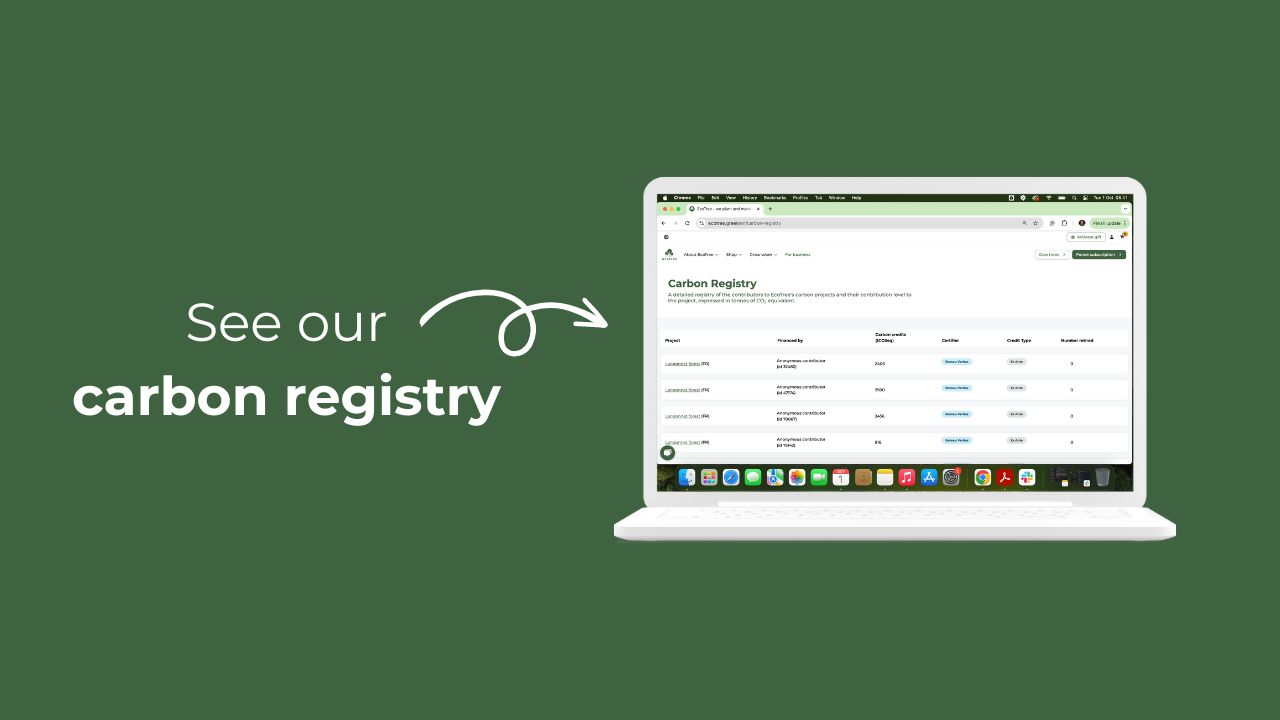Sep 30, 2024
Why a carbon registry is essential for transparency on the carbon market
Learn how carbon registries ensure transparency in the carbon market by tracking credits from creation to retirement.

Each carbon credit is recorded in a registry, ensuring transparent traceability because it proves that concrete action has been taken, preventing greenwashing and supporting global climate goals.
Although traded on the voluntary carbon market (VCM), the carbon credits we deliver to our partner companies meet strict criteria: additionality, permanence, uniqueness, and verifiability. To be adequately monitored, these credits must be entered into a registry, guaranteeing transparency and confirming when a credit has been retired. This traceability mechanism offers companies the transparency they need to validate their environmental commitments to stakeholders. Here's how a carbon registry works:
First, what are carbon credits, and what is their purpose?
1. Carbon credits play a crucial role in combating climate change
Carbon credits enable companies to contribute to global carbon neutrality and consequently assist in combatting climate change on a global scale. A carbon credit represents a certificate that verifies the reduction, avoidance, or capture of one tonne of CO₂ or other greenhouse gases through a specific project. This may involve afforestation, reforestation, energy efficiency, or carbon capture technologies. It symbolises a tangible and verified action governed by international standards, which ensures a direct contribution to addressing global warming.
2. Carbon credits must meet 4 main criteria
The creation of a carbon credit is based on several rigorously defined criteria. First, additionality is key: it must be demonstrated that the project would not have taken place without the financial support generated by the sale of carbon credits. Then, permanence guarantees that the emissions reductions or CO₂ captures are long-lasting and irreversible and will not be negated in the future, particularly in afforestation projects. The criteria of measurability and verifiability ensure that an independent third party can regularly assess and confirm the project's outcomes. Finally, the credits must be unique to prevent double-counting or fraudulent resales, ensuring the system's integrity.
While the criteria of additionality, permanence, and verifiability are widely discussed in the literature, the uniqueness criterion—and, therefore, the role of the registry—is less frequently addressed, as it often seems self-evident. However, carbon credit traceability is a fundamental element of the system, safeguarding the credibility and integrity of the market. Without a centralised and secure registry, it would be impossible to guarantee that each carbon credit can only be used once and that companies' contributions are not merely "greenwashing."
Here’s everything you need to know about carbon credits.
What is a carbon registry?
A public carbon registry allows tracking of each carbon credit from its creation to its final retirement, including any transfers along the way. This registry system ensures that once a credit has been used to offset an emission, it cannot be traded or resold, thus preventing double-counting. This traceability mechanism provides businesses with the transparency they need to validate their environmental commitments to their stakeholders, including consumers, investors, and regulators. Additionally, it creates a clear and tamper-proof history of the origin and usage of credits, strengthening trust in the validity of carbon contribution actions.
Why is a carbon registry important for the traceability of carbon credits?
Currently, carbon credit registries can be maintained by either the independent certifying body or the project developer. As a result, many registries coexist. Under the proposal to establish the first certification framework for carbon removals at the EU level, the European Commission may adopt implementing acts to establish the structure, format, and technical details of public registries and the registration, ownership, or usage of carbon credits. With this future European regulation, public certification registries will be managed by the body overseeing the certification system, with a requirement for interoperability to prevent double-counting. The establishment of a single registry, managed by the European Commission and potentially called the "Union Registry", is also under consideration. On this point, the European Parliament has amended Article 12 of the proposed regulation. It stipulates that "the Commission shall establish and maintain a public registry to make information on the certification process accessible to the public in a transparent manner."
Furthermore, the Council of the European Union, in its mandate, invites the Commission to establish, four years after the regulation enters into force, a common EU-wide electronic registry to store documents related to the certification process, including certificates and audit summaries and facilitate public access to this information. In the meantime, certification systems under the framework must provide public registries based on automated and interoperable systems.
EcoTree's registry is a robust database
In line with its values of transparency and rigour and committed to upholding the highest standards of integrity and quality for carbon credits, EcoTree has, for years, worked on creating a robust database where each carbon credit, each tree, and every ownership link is recorded with a unique identifier. Based on forest management plans, EcoTree estimates the future value of timber production as well as the long-term average carbon stock, thus defining the value of the trees and the number of carbon credits associated with the project. These calculations, along with the notions of additionality and discounts, are validated by Bureau Veritas.
Each carbon credit is then entered into the database with a unique identifier. The ownership of these credits is also tracked within the database, associating the user with the carbon credit via a unique ownership link. This link, thanks to the unique index tied to the credit identifier, ensures the integrity of the data by preventing any duplication: the database will reject the assignment of the same identifier twice, whether due to human or automated error. Thus, every carbon credit and ownership link is distinctly and uniquely tracked, ensuring transparency and reliability in all transactions.
The registry finalises the consumption of carbon credits
The carbon registry is the official record of a carbon credit's lifecycle, and it's important to remember that a credit is considered "consumed" and has its compensatory effect when its owner publicly declares having offset part of their greenhouse gas emissions by associating an equivalent amount of captured CO₂ with those emissions. The owner must then request the credit's retirement from the registry, with this responsibility resting on their good faith. The owner also commits not to resell a credit that has already been consumed, under the risk of civil or even criminal liability in some cases.
Ultimately, carbon credit registries are much more than mere transaction management tools. They ensure transparency, traceability, and verification of companies' carbon contribution actions, thereby enhancing the credibility of the carbon market. By relying on registries governed by rigorous standards, companies can achieve their carbon contribution targets and demonstrate their commitment to responsibly tackling climate challenges.
*EcoTree Carbon Registry is available to anyone with an EcoTree account.












